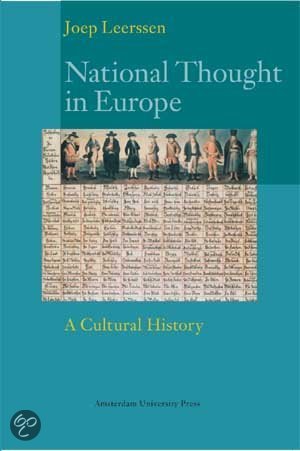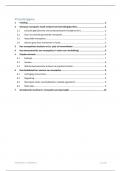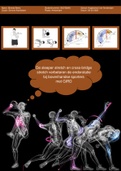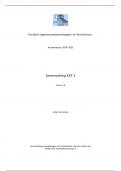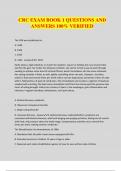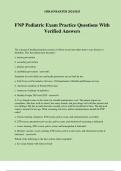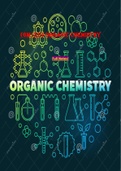(Readings for the lectures per week)
Week 1
Aug. 31 Introduction
Pages 13-21
In this book nationalism is traced as a cultural phenomenon: it emanates from the way that
people view and describe the world.
The ideology nationalism:
-‐ A ‘nation’ is the natural and organic subdivision of humanity it has a claim to
loyalty
-‐ The state’s mandate and sovereignty derives from a constituent nation national
solidarity extends into civic loyalty
-‐ National lines divide territories and socio-politics ideally a state contains it’s entire
constituent nation
Nationalism in the early 1800’s emerged as an ideological movement for attaining and
maintaining autonomy etc. French revolution to WW I
This ideology emerged out of a long run up.
National thought: human society consists of different nations each have a separate identity
and culture and have the right to exist and command loyalty
What is a nation? Three poles:
-‐ Society
-‐ Culture
-‐ Race
A nation-state: a state that claims to represent and incorporate a nation
Alternative: ethnicity (the collective acceptance of a shared self-immage). Ethnie of a group
is not based on shared physical appearance etc. but on the acknowledgement of differences
and similarities.
Ethnicity has become a euphemism for race ethnic nationalism, ethnic cleansing….
The system of nationalism must be located in the tradition of ethnotypes this book is a
cultural history of nationalism in Europe.
It is impossible to generalize the development of nationalism and state- and nation-formation
in the entire world.
Europe is a zone of traffic and exchange: national thought is mobile. This traffic outlines the
borders of Europe. Before 1800 the traffic was confined in the elite sphere of N-W Europe.
During the nineteenth century nationalism spread.
The book:
Part 1. Trace the developments of state centralization from the end of the Middle Ages
onwards Enlightenment and the ideas of what a nation is.
Part 2. Traditions are fused together into the ideology nationalism Napoleonic rule.
,Early nationalism = political romanticism
Ideal congruence between nation and state leads to:
-‐ State centralism
-‐ National unification ideal
-‐ Separatist movement
In al cases the ideology is still a believe in ethnotypes
Part 3. The slide of nationalism from the left- to the right-wing. The transition from cultural
self-assertion to territorial demands.
Part 4. A concluding survey of the twentieth-century aftermath.
Sept. 2 Languages and Religions in Europe
Pages 255-268
Languages, alphabets, dialects and language politics
Non-Indo-European languages
-‐ Saami (Lapland and Northern Finland, Sweden and Norway)
-‐ Finnish and Estonian
-‐ Hungarian (remotely related to Finnish)
-‐ Turkish
-‐ Maltese (related to North African Arabic)
-‐ Basque
-‐ Hebrew
Indo-European languages
Celtic – North-Western EU Gaulish*
Irish Gaelic, Scots Galic
Welsh, Breton
Germanic – Alps to Iceland Danish, Icelandic, Faroese, Norwegian, Swedish
English, Frisian, German, Netherlandic
Variants: Luxemburgish, Yiddish
Slavic Church Slavonic*
East-Slavic group: Belorussian, Russian, Rusyn/Ukrainian
West-Slavic group: Czech, Polish, Slovak
South-Slavic group: Bosnian/Croat/Serbian, Bulgarian, Macedonian,
Slovene
Romance – English channel to Latin*
Northern Mediterranean French, Italian, Portuguese, Romanian, Spanish
Catalan, Corsican, Galego, Occitan/Provençal,
Rhaeto-Romance, Sardinian
Separate Indo-European languages: Albanian, Greek, Latvian and Lithuanian,
Roma/Sinti (“Gypsy language”)
*Extinct or liturgical
These main branches number ca. 55 languages. Only ca. 30-35 languages are the (co-)official
languages of an independent state a third/quarter of the European languages are only
regional recognized or not at all
, Scripts and alphabets
The five main alphabets used in Europe are a result of church history
-‐ Arabic Koran. Used throughout the Islamic world. Also used in Turkey (Ottoman
Empire) until 1928 and Moorish Spain
-‐ Hebrew liturgical purposes, the language of Israel, Yiddish
-‐ Greek ancient Greece and Eastern Roman Empire. Still used in Greece and Cyprus
and Greek-Orthodox church
-‐ Cyrillic Slavic languages and Slavic orthodox churches. Was derived from the
Greek alphabet
-‐ Latin Western Christianity
Closely related Slavic languages use different alphabets, depends on which religion is
involved.
Renaissance Italian humanists made the standard western letter from Latin alphabet, but
protestant countries kept manuscript variants of scripture.
Linguistic taxonomy
Middle Ages: from Noah’s sons tribes descended 27 nations and languages. Hebrew was
the oldest and central language.
16th and 17th century: comparison of languages through Bible translations. Romance and
Germanic ‘family’ was recognized.
18th century: Hebrew and non-European languages led to linguistic confusion.
Early 19th century: Sir William Jones realized Sanskrit was related to Greek, English and
Latin but not to Hebrew or Turkish Indo-European model
Languages and dialects
There are no hard criteria to give a linguistic variant the status dialect or language no
distinction made between dialect difference and language difference by linguists.
Dialect variations are considerable, but some languages are extremely closely related.
People make a distinction between languages and dialect, although fundamental differences
are hard to find.
Language: communication of a state, taught in schools, literature
Dialect: non-official means of communication in a community/region, oral, history is not
recorded
Distinction is not absolute: Frisian and Provençal have literary presence. Afrikaans has
evolved from a dialect to a language.
Languages are the vehicles of communication in a public sphere and the attempt to have
one’s local idiom raised to the status of a language is often the prime concern of a national
movement.
Language politics
Language was important for the 19th century nationalist movements in Europe: the outlines of
a state should be outlined onto the territorial pattern of culture.
Already language improvers and purists existed in the 17th and 18th century, long before
modern nationalism emphasised language the very core of ethnicity.
Legal-linguistic concerns can be traced back further than Romantic linguistic philosophy and
modern nationalism.
Belgium as an example: feudal lordships in 14th century already kept law books in two
languages. Over the centuries one problem is consistent in Belgium: correspondence with the

